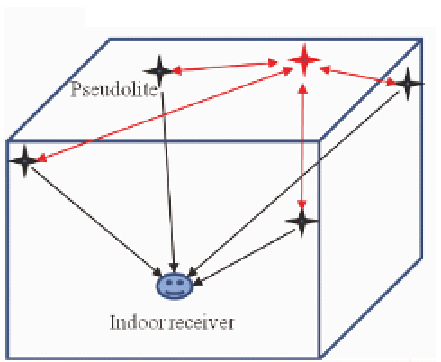Global Positioning System Reference
In-Depth Information
away from each other if one uses the optimal number of transmitters (i.e. four in a 3D
positioning system).
Additional Pseudolite for synchronisation
Pseudolite
Indoor receiver
Fig. 6. Pseudolite indoor positioning system
3.4 Advantages and main drawbacks
Such an indoor positioning system is not widely deployed because of numerous major
drawbacks, despite some fundamental advantages. Let us list the most important features
and comment on whether they are an advantage or a drawback (Kanli 2004).
Continuity with outdoor GNSS
: this is obviously a major advantage of the proposed system.
Moreover, the continuity is obtained by using the same hardware as for outdoors (since
GNSS are clearly a very good candidate when the satellites are visible and is almost free
12
).
Note that using GNSS-like signals means that current receivers are already capable, with a
software update, of processing them. This fact constitutes a second major advantage. The
first drawback is the need for a local infrastructure.
Synchronisation between pseudolites
is required. Satellites include atomic clocks or masers in
order to reduce significantly the time drift but require a terrestrial infrastructure for
synchronisation purposes. In the case of pseudolites, two approaches have been proposed:
synchronous and asynchronous systems. In the latter case, the pseudolites are not
synchronised and the measurement technique must carry out a sort of synchronisation: the
method used is the double differencing that allows us to get rid of the synchronisation of the
transmitters. The major drawback is then the need for a reference receiver that should be in
radio visibility of the transmitters. Apart from the deployment complexity that this adds, a
data link has to exist between the two receivers. This first approach is not intended to be
selected for indoor positioning purposes. The other approach uses synchronous pseudolites.
Several methods have been proposed: the simplest one in theory, but not in practice, is to
link the various transmitters by wire. In such a case a sort of calibration phase is required in
order to know precisely the delay between pseudolites. An implementation of this approach
used a master receiver located in a known location with respect to all the pseudolites.
12
A GNSS receiver integrated into a modern device is estimated to cost a few dollars.





Search WWH ::

Custom Search